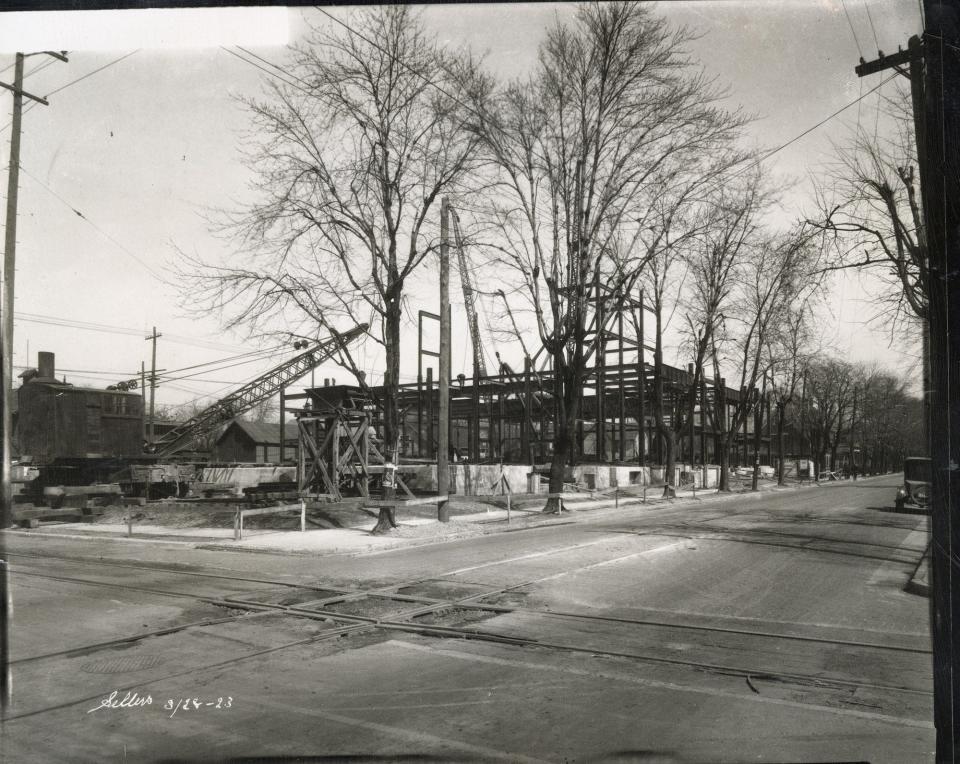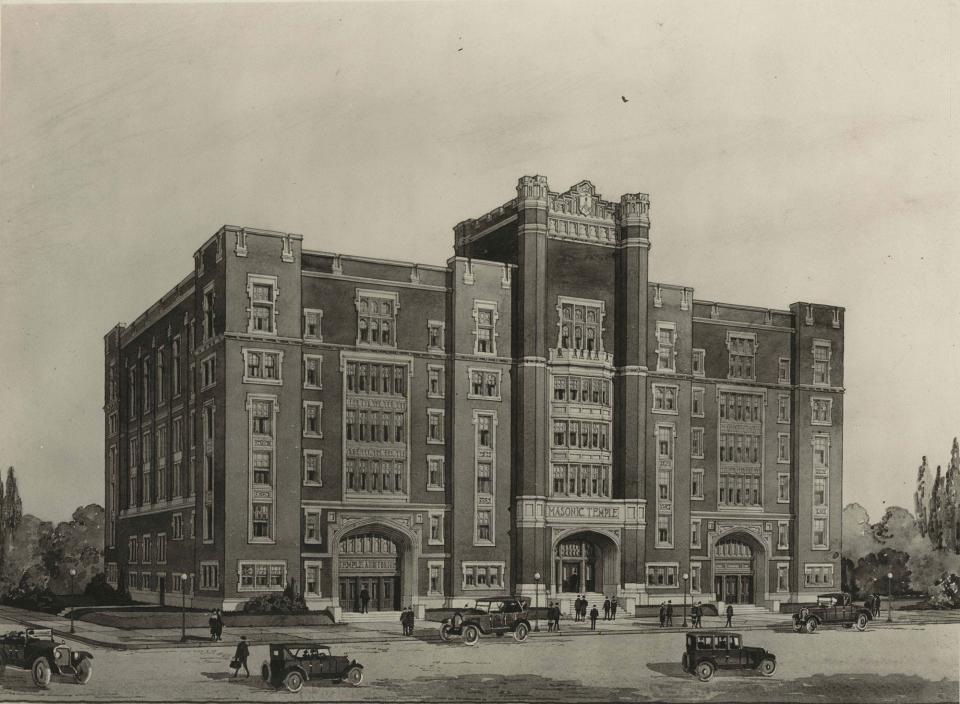ByGone Muncie: Well formed, true and trusty
MUNCIE, Ind. – Historic preservationists are my favorite Munsonians. They literally preserve history as part of our functional, built environment. All buildings need maintenance, but old ones require a special commitment rooted in the belief that a property’s true value is determined by something more than just market price.

This value is hard to measure, but easy to recognize. Historic buildings, especially those with outstanding architectural significance, beautify public spaces while connecting us to forebears under the same roof. Old buildings also fix collective memories on the landscape. Those that preserve them are legit heroes, in my opinion, because they protect the very brick and mortar that defines our community across generations.
One of Muncie’s best preservationists is Russell Irving. He recently restored Heartwood Hall, the gorgeous Colonial Revival mansion at the northwest corner of Hackley and Adams streets. The house was built in 1896 for Suzanne Little Thomas by a Ft. Wayne architect named Alfred Grindle. When built, the Muncie Daily Times remarked that the house was “one of the most beautiful in eastern Indiana.” Irving’s restoration gilds that corner of Hackley and Adams, while making it more likely that Heartwood Hall stands beautiful for another century.
Preservationists like Irving work all across Delaware County. However, I’d like to call attention to one that rarely gets any recognition, Cornerstone Center for the Arts. The nonprofit’s mission is to provide “opportunities for creative expression, educational programs, and events in a historic setting.” That historic setting, of course, is the magnificent 1926 Masonic Temple at the northeast corner of Main and Madison streets.
You probably read recently that Cornerstone paused its fall classes to reassess how best to move the organization forward. It’s not that they aren’t successful, it’s just, as they put it in a press release, “the cost to maintain our grand 1920s Masonic Temple building often exceeds revenue.”
The Masonic Temple was built at the end of the Golden Age of Fraternalism, a time when sororal and fraternal societies flourished between the Civil War and the Great Depression. Delaware County had many societies, so much so that historian Frank Haimbaugh wrote in 1924, “some say that Muncie is overlodged; that is, that there are too many secret societies carrying on their respective activities in proportion to the population.” These included, to name just a few: Odd Fellows, Knights of Pythias, Red Men, Knights of Maccabees, Elks, Knights of Columbus, B’nai B’rith, Eagles, Modern Woodmen, Foresters, Moose, and yes, even the Ku Klux Klan.

Yet, of all the fraternal associations in Muncie and Delaware County, Masonry was the most popular. The first local Freemasons formed Delaware Lodge #46 in 1843. They met in several places including the courthouse and at a small brick structure in the southwest corner of Main and High streets. They laid a cornerstone in 1863 for the first Masonic building across the way at the northwest corner of the same intersection. Membership grew exponentially and a cornerstone for a new building was laid in 1905 at 211 W. Main.
Masonic bodies formed across Delaware County during the same period, including at New Burlington, Albany, and Eaton. Segregated at the time, Muncie’s African American Masons (Prince Hall) formed Widow’s Sons Lodge #22 in 1891. In the 1890s, they met at an upper floor in the Willard Building.
Emerson’s Muncie city directory lists six Masonic bodies in 1919: Delaware Lodge #46, Muncie Lodge #433, Muncie Chapter #30 (Royal Arch), Muncie Council #16 (Cryptic), Muncie Commandery #18 (Knights Templar), and Muncie Chapter #104 (Eastern Star).

Muncie’s Masons ran out of space again after the end of the First World War. They needed something bigger and formed the Muncie Masonic Temple Association in 1919 to develop a grand new building. In July of that year, the Muncie Star wrote that “a section of ground at the northeast corner of Main and Madison streets has been bought by the lodge for the purpose of erecting the new building.” The Star concluded that it “will far surpass all other structures in the city for beauty of architecture.”
The Temple Association hired local architect Cuno Kibele of Kibele & Garrard to design the structure. Kibele is Muncie famous for many buildings, including Ball Gym, Burkhardt Building, Ball Memorial Hospital, YWCA, Wilson School Apartments, Rose Court, and many others.
Given the temple’s planned grandeur, it took years for local Masons to raise the money. Work eventually began when Muncie’s own Indiana Bridge won the bid to make the steel frame, which went up in 1923. The Masons laid the cornerstone on October 30 that year. The Muncie Evening Press reported “the cornerstone for the new Masonic Temple on East Main street was placed in its position by officers of the Grand Lodge of Indiana.” Ceremonies were “conducted in true Masonic style and after the stone had been carefully examined, it was announced ‘well formed, true and trusty.’ With these words, the laying of the corner-stone was completed.”
Five thousand Hoosier Freemasons attended the ceremony, which was followed by an afternoon parade. Apparently the entire city of Muncie turned out for it. The Star wrote that “several factories closed for the entire day, and all banks closed at noon to permit their employees to participate in the celebration.”
The Temple Association hired locally and regionally. The plumbing contract went to Hutzel and Company of Muncie, while Smith Electric did the wiring. William Vehling of Indy was hired for all plastering. Matthews Brothers of Bloomington supplied Indiana Limestone, while David Eshelman and Sons of Anderson won the general construction contract. Chicago artist Gustave Brand was commissioned to paint 28 murals.
The Masonic Temple was all but completed at the grand dedication on November 27, 1926. The building had cost the city’s Masons $1,000,000 (~$17,000,000 today). Two-thousand donors gave anywhere from $25 to $150,000 for the effort. At the time, it was the largest York Rite Masonic Temple in the world.
Membership declined rapidly during the Great Depression and went steadily downhill after the war until the end of the century. The Masons sold the building and left in the mid-2000s. Cornerstone Center for the Arts formed in 2006 when Muncie Center for the Arts merged with Community Arts and Building Foundation, owners of the Masonic Temple at the time. Cornerstone has maintained the edifice ever since.
As they reassess how to move forward, I hope our community rallies in support. But for the moment, we should at least recognize Cornerstone’s noble stewardship in keeping one of Muncie’s most beautiful buildings a going concern.
Chris Flook is a Delaware County Historical Society board member and a Senior Lecturer of Media at Ball State University.
This article originally appeared on Lafayette Journal & Courier: ByGone Muncie: Well formed, true and trusty

